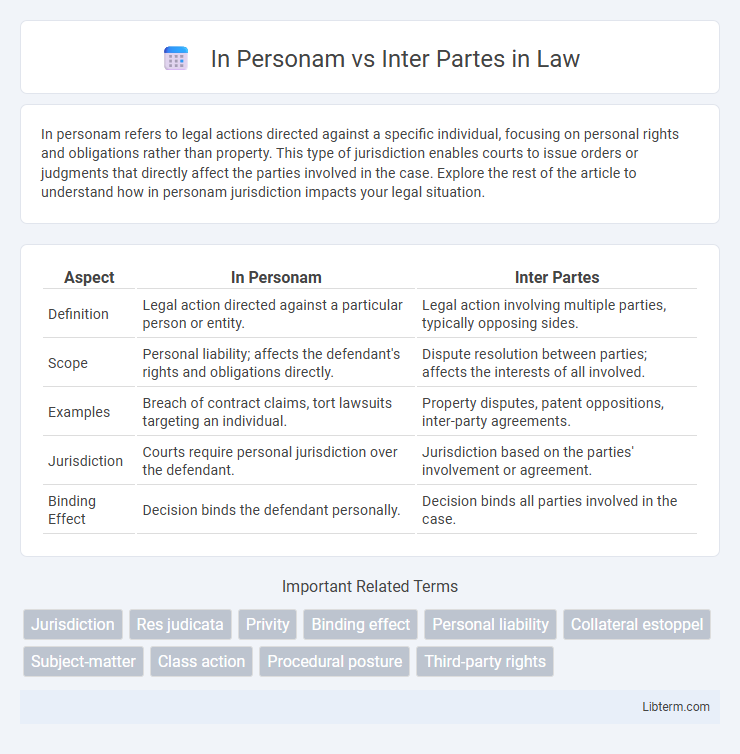In personam refers to legal actions directed against a specific individual, focusing on personal rights and obligations rather than property. This type of jurisdiction enables courts to issue orders or judgments that directly affect the parties involved in the case. Explore the rest of the article to understand how in personam jurisdiction impacts your legal situation.
Table of Comparison
| Aspect | In Personam | Inter Partes |
|---|---|---|
| Definition | Legal action directed against a particular person or entity. | Legal action involving multiple parties, typically opposing sides. |
| Scope | Personal liability; affects the defendant's rights and obligations directly. | Dispute resolution between parties; affects the interests of all involved. |
| Examples | Breach of contract claims, tort lawsuits targeting an individual. | Property disputes, patent oppositions, inter-party agreements. |
| Jurisdiction | Courts require personal jurisdiction over the defendant. | Jurisdiction based on the parties' involvement or agreement. |
| Binding Effect | Decision binds the defendant personally. | Decision binds all parties involved in the case. |
Understanding In Personam: Definition and Scope
In Personam jurisdiction refers to a court's power to adjudicate matters involving specific individuals or entities, based on their personal rights and obligations. It typically requires the defendant to have sufficient minimum contacts with the forum state, ensuring the court's authority is appropriately exercised over the party. This scope contrasts with In Rem or Quasi in Rem jurisdiction, which centers on property rather than personal liabilities.
Exploring Inter Partes: Meaning and Applications
Inter Partes refers to legal proceedings or actions involving specific parties directly affected by the dispute, where rights and obligations are determined between those individuals or entities. This concept is commonly applied in patent oppositions, administrative hearings, and contractual disputes where decisions impact only the parties involved rather than the public or third parties. Understanding Inter Partes processes is crucial for navigating dispute resolution mechanisms that emphasize bilateral or multi-party engagement under procedural law.
Key Differences Between In Personam and Inter Partes
In personam actions target specific individuals personally liable, establishing rights or obligations directly between the parties involved, whereas inter partes proceedings affect all parties with a legal interest in the matter, often involving disputes over rights or properties. In personam jurisdiction requires the court's authority over the defendant's person, while inter partes jurisdiction involves proceedings between parties before the court, impacting their legal status or rights. Key differences lie in the scope of effect, with in personam judgments binding only the parties personally involved, and inter partes judgments affecting third parties or a broader legal right.
Legal Implications of In Personam Proceedings
In personam proceedings involve legal actions directed against a specific individual or entity, establishing personal jurisdiction over the defendant. These proceedings enable courts to issue binding judgments affecting the defendant's rights and obligations, including property rights and liabilities. The legal implications include enforceability of judgments beyond the immediate parties and potential impact on the defendant's legal status in subsequent cases.
Legal Implications of Inter Partes Proceedings
Inter Partes proceedings involve disputes between specific parties, contrasting with In Personam actions that target individuals personally. These proceedings have legal implications such as the necessity for proper party notification, ensuring fair opportunity to present evidence and arguments. The judgments rendered in Inter Partes cases bind only the parties involved, limiting the scope of enforceability and creating distinct precedential value.
Common Examples of In Personam Cases
In personam cases typically involve lawsuits where the court's judgment binds a specific individual or entity, commonly seen in contract disputes, tort claims, and family law matters such as divorce or child custody. These cases focus on personal obligations and rights, requiring direct participation of the involved parties. In contrast, inter partes proceedings usually address issues between parties but may involve public rights or property, such as trademark oppositions or patent disputes.
Typical Scenarios for Inter Partes Cases
Inter Partes cases typically involve disputes between specific parties where the rights or obligations are contested, such as patent oppositions or trademark oppositions filed by competitors challenging the validity of intellectual property rights. These scenarios often include proceedings like inter partes review (IPR) in patent law, where a third party petitions the patent office to cancel or amend claims of an existing patent. The defining characteristic of Inter Partes is the direct adversarial interaction between parties, as opposed to In Personam actions that address rights or obligations affecting an individual personally.
Jurisdictional Considerations: In Personam vs Inter Partes
Jurisdictional considerations distinguish In Personam and Inter Partes actions primarily by the parties affected and the courts' authority scope. In Personam jurisdiction grants courts power over a particular person or entity, requiring personal service and minimum contacts with the forum state to ensure fairness. Inter Partes jurisdiction, in contrast, involves disputes between parties about specific rights or interests, often related to property or contracts, where jurisdiction depends on the subject matter and parties' consent rather than personal service.
Impact on Third Parties: Comparing Both Concepts
In personam judgments affect only the parties involved, restricting enforcement and obligations exclusively to them, while inter partes proceedings create effects binding on all parties, including third parties who are directly involved or have a legal interest. The impact on third parties is more pronounced in inter partes cases as it may influence their rights or obligations without necessitating their direct participation. In contrast, in personam decisions typically do not impose obligations or confer rights upon third parties beyond those explicitly named in the judgment.
Choosing the Appropriate Legal Action: In Personam or Inter Partes
Choosing between In Personam and Inter Partes legal actions depends on the nature of the dispute and the parties involved. In Personam actions target specific individuals or entities, creating binding judgments directly affecting the defendant's rights and obligations, suitable for cases requiring personal liability. Inter Partes procedures involve multiple parties and are often procedural or administrative, addressing disputes that affect broader rights or property interests among several stakeholders.
In Personam Infographic

 libterm.com
libterm.com